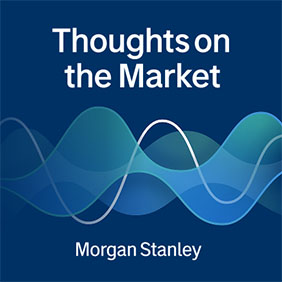Can AI Make Healthcare Less Expensive?
September 9, 2025
Many Americans struggle with the rising cost of healthcare. Analysts Terence Flynn and Erin Wright explain how AI might bend the cost curve, from Morgan Stanley’s 23rd annual Global Healthcare Conference in New York.

Thoughts on the Market
Listen to our financial podcast, featuring perspectives from leaders within Morgan Stanley and their perspectives on the forces shaping markets today.

Up Next
A New Bull Market Begins?
Transcript
Welcome to Thoughts on the Market. I'm Mike Wilson, Morgan Stanley’s CIO and Chief U.S. Equity Strategist. Today on the podcast I’ll be discussing Friday’s Payroll report and what it means for equities.
It's Monday, Sept 8th at 11:30am in New York. So let’s get after it.
The heavily anticipated nonfarm payroll report on Friday supports our view that the labor market is weak. However, this is old news to the equity market as we have been discussing for months. First, the labor market data is perhaps the most backward-looking of all the economic series. Second, it’s particularly prone to major revisions that tend to make the current data unreliable in real time, which is why the National Bureau of Economic Research typically declares a recession started at a time when most were unaware we were in one.
Furthermore, history suggests these revisions are pro-cyclical, meaning they get more negative going into a recession and then more positive once the recovery’s begun. It appears this time is no different. Indeed, Friday’s revisions were better than last month’s by a wide margin suggesting the labor market bottomed in the second quarter.
This insight adds support to our primary thesis on the economy and markets that I have been maintaining for the past several years. More specifically, I believe a rolling recession began in 2022 and finally bottomed in April with the tariff announcements made on “Liberation Day.” After the initial phase of this rolling recession, that was led by a payback in Covid pull-forward demand in tech and consumer goods, other sectors of the economy went through their own individual recessions at different times.
This is a key reason why we never saw the typical spike in the metrics used to define a traditional recession, although the revisions data is now revealing it more clearly. The historically significant rise in immigration post-covid and subsequent enforcement this year have also led to further distortions in many of these labor market measures. While we have written about these topics extensively over the past several years, Friday’s weak labor report provides evidence of our thesis that we are now transitioning from a rolling recession to a rolling recovery. In short, we're entering a new cycle environment and the Fed cutting interest rates will be key to the next leg of the new bull market that began in April.
Central to our view is the notion that the economy has been much weaker for many companies and consumers over the past 3 years than what the headline economic statistics like nominal GDP or employment suggest. We think a better way to measure the health of the economy is earnings growth, and breadth; as well as consumer and corporate confidence surveys. Perhaps the simplest way to determine if an economy is doing well or not is to ask: is it delivering prosperity broadly? On that score, we think the answer is “no” given the fact that earnings growth has been negative for most companies over the past 3 years. The good news is that growth has finally entered positive territory the past 2 quarters. This coincides with the v-shaped recovery in earnings revisions breadth we have been highlighting for months. We think this supports the notion that the worst of the rolling recession is behind us and likely troughed in April. As usual, equity markets got this right and bottomed then, too.
Now, we think a proper rate cutting cycle is likely and necessary for the next leg of this new bull market. Given the risk that the Fed may still be focused on inflation more than the weakness in the lagging labor market data, rate cuts may materialize more slowly than what equity investors want. Combined with some signs that liquidity may be drying up a bit as both corporate and Treasury issuance increases, it would not surprise me if equity markets go through some consolidation or even a correction during the seasonally weak time of the year. Should that happen, we would be buyers of that dip and likely even consider moving down the quality curve in anticipation of a more dovish Fed and coordinated action with the Treasury. Bottom line, a new bull market for equities began with the trough in the rolling recession that began in 2022. It’s still early days for this new bull which means dips should be bought.
Thanks for tuning in; I hope you found it informative and useful. Let us know what you think by leaving us a review. And if you find Thoughts on the Market worthwhile, tell a friend or colleague to try it out!

The Credibility of Inflation Targets
Transcript
Arunima Sinha: Welcome to Thoughts on the Market. I'm Arunima Sinha, Global Economist at Morgan Stanley.
Today I'm going to talk about how inflation targets of central banks matter for market participants and economic activity.
It's Tuesday, August 12th at 10am in New York.
Tariff driven inflation is at the center of financial market debates right now. The received wisdom is that a central bank should look through one-off increases in prices if – and it is an important if – inflation expectations are anchored low enough. Inflation targets, inflation expectations, and central bank credibility have been debated for decades.
The Fed's much criticized view that COVID inflation would be transitory was based on the assumption that anchored inflation expectations would pull inflation down. The Fed is more cautious now after four years of above target inflation. Can a central bank simply announce an inflation target and get everyone to believe it?
Far away from the U.S., the South Africa Reserve Bank, SARB, is providing a real time experiment. The SARB’s inflation target was originally a range of 3 to 6 per cent, with an intention to shift to 2 to 4 percent over time. At its last meeting, the SARB announced that it was going to target the bottom end of the range, de facto shifting to a 3 percent target. A decision by the Ministry of Finance in the coming months is likely necessary to formalise the outcome, but the SARB has succeeded in pulling inflation down. It has established credibility, but we suspect that more work is needed to anchor inflation expectations firmly at 3 percent.
Key to the SARS challenge, as the Fed’s – the central bank cannot control all the drivers of inflation in the short run. For South Africa, fiscal targets and exchange rate movements are prime examples. The experience in Brazil offers insight for South Africa. The BCB adopted an inflation target in 1999 following the end of the currency peg that helps the transition away from hyperinflation. The target was initially set at 8 percent, lowered to 4.5 percent in 2005, and then lowered again to 3 percent in 2024.Fiscal outcomes, market expectations, and currency volatility have been hard to contain. The lessons apply to South Africa and also the Fed. Successful inflation targeting relies on a clear framework, but also on institutional strength and political consensus.
For South Africa, as inflation falls ex-ante real interest rates will rise. That outcome will be necessary to restrain the economy enough to make sure that the path to 3 percent is achieved. For an open EM economy, there likely needs to be consistency by both monetary and fiscal authorities with regard to short-term pressures, both internal and external.
While we ultimately expect the SARB to be able to anchor inflation expectations, the journey may not be a quick one; and that journey will likely depend on keeping real interest rates on the higher side to ensure the convergence.
We take the experiences of South Africa and Brazil to be informative globally. Simply announcing an inflation target likely does not solve the problem. The Fed, for example, spent much of the 2010s hoping to get inflation up to target – while now ironically, inflation in the US has run above target for almost half a decade.
Whether the lingering effects of the COVID inflation has affected the price setting mechanism is unclear, as is whether tariff driven inflation will exacerbate the situation. Our read of the evidence is that inflation expectations and central bank credibility come from hitting the target, not from announcing it.
Thanks for listening. If you enjoy the show, please leave us a review wherever you listen and share thoughts on the market with a friend or colleague today.

Sign up to get Morgan Stanley Ideas delivered to your inbox.
Thank You for Subscribing!
Would you like to help us improve our coverage of topics that might interest you? Tell us about yourself.



